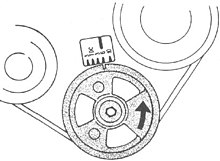
A pinch point or pinch point hazard is a common class of mechanical hazard where injury or damage may be done by one or more objects moving towards each other, crushing or shearing whatever comes between them. A nip point is a type of pinch point involving rotating objects, such as gears and pulleys. Injuries can range from minor such as blisters to severe like amputations and fatalities. Examples of pinch point hazards include gaps in closing doors and objects swinging or being lowered near fixed objects.
| This section needs expansion. You can help by adding to it. (August 2020) |
Common causes of injuries
- Poor situational awareness
- Proximity to mobile equipment and fixed structures
- Loose clothing, hair or jewelry getting caught in rotating parts or equipment
- Inadequate safety barriers
- Handling errors
- Wrong work procedures or tools
- Reaching into moving equipment
| This section needs expansion. You can help by adding to it. (August 2020) |
Safety controls

Pre-work hazard inspections can be performed to identify pinch point hazards. These hazards can be managed with control methods, listed below according to the hazard control hierarchy.
Engineering controls physically prevent objects from entering the pinch point.
- Barriers and machine guards
Administrative controls inform worker behavior to avoid pinch points.
- Area demarcation
- Lockout–tagout
- Situational awareness
- Use of appropriate training, work procedures, instructions, and operating manuals
Personal protective equipment protects individuals exposed to the hazard by preventing objects from being pinched.
| This section needs expansion. You can help by adding to it. (August 2020) |
.
See also
- Hazard – Situation or object that can cause harm
- Mechanical hazard- Hazard with a mechanical energy source
- Occupational hazard – Hazard experienced in the workplace
- Physical hazard – Hazard due to a physical agent
References
- ^ "Causes and controls for preventing pinch point injuries". Industrial Safety and Hygiene News. 9 February 2018. Retrieved 8 August 2020.
- ^ "Woodworking eTool | Machine Hazards > Nip Points". www.osha.gov. Retrieved 2020-10-22.
- Environmental Health and Safety. "WVU Pinch Point Hazards" (PDF). West Virginia University. Retrieved 15 October 2020.
- Middle Georgia State University. "Pinch Points: Safety Training" (PDF). Retrieved 3 October 2020.